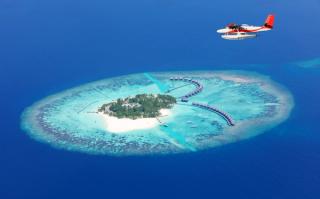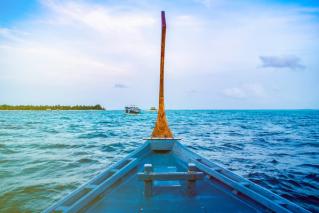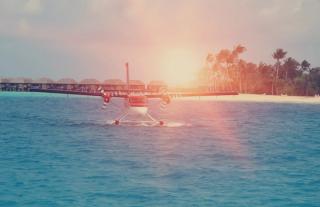Maldives - Seaplane or Speedboat? Which is Better?

Deciding between a seaplane or speedboat for your Maldives transfer is about choosing your first adventure in paradise.
Seaplanes offer stunning aerial views and are perfect for those arriving by day, taking you directly to remote islands. On the other hand, speedboats are ready whenever you arrive, giving you a closer look at the ocean and minimal waiting.
Your choice boils down to when you land, where you're staying, and the experiences you prefer as you set off to your island retreat.
Seaplane vs speedboat considerations:
Resort Accessibility

Before considering any other factors it’s important to note that not all resorts are accessible by all transfer methods.
The options available are largely dictated by geography.
Islands close to Malé will usually be accessible by speedboat only, whilst those in the surrounding atolls are typically resorts reached by seaplane. There's also a third option for the medium to far islands which is a domestic transfer followed by a short boat ride from an airport closer to the resort.
If you have your heart set on a particular resort the choice between seaplane and speedboat may already be made for you!
The Experience

Seaplanes provide not just a mode of transport but an experience in their own right. This alone can sway the balance for many visitors.
As you ascend from Malé and travel just a couple of thousand feet above the ocean, the sight of the archipelago stretching below is nothing short of breath-taking. The patchwork of islands—some no larger than a sandbank, others hosting sprawling resorts—offers a perspective that's reserved for those who choose resorts by seaplane. Even simply taking off from and landing on the turquoise water is an experience in itself.
Whilst speedboat transfers can be a thrilling ride, skimming across the crystal-clear waters of the Indian Ocean with the wind at your back, there are plenty of opportunities to venture out by boat during your holiday.
Perhaps the biggest draw for speedboat transfers in terms of experience is that it’s quick and seamless. There are fewer potential delays from scheduling and weather, and less waiting between your international arrival and resort transfer, which is particularly relevant if you’re only making a short stop in the Maldives.
Winner: Seaplane
Cost
Cost is a significant differentiator between seaplanes and speedboats in the Maldives. Seaplane transfers, often seen as the more glamorous option, come with a higher price tag, reflecting their ability to deliver you directly to far-flung resorts with prices ranging from a few hundred to several hundred dollars per person for a round trip.
For those that really want to push the plane out it's possible to charter a private seaplane with VIP layout for a 5 figure sum.
Speedboats are usually kinder on the wallet. Actual price depends on the distance from Malé and the level of the service and vessel used by the resort. These can vary from basic dhonis to exotic yachts.

One caveat to be aware of is that resorts arrange transfers on your behalf and also set the price, and no, you can’t do this yourself. In general everything costs more at the more luxurious resorts, meaning a short speedboat journey to a top luxury resort could cost more than a seaplane transfer to a more basic resort.
Transfers are also not normally included in resort prices, though may be as part of a promotion or package. Therefore, when budgeting for your Maldivian holiday, the choice between seaplane and speedboat could significantly impact your overall expenditure. Speedboat is usually cheaper, but don't assume it's always the case.
Winner: Speedboat
Arrival / Departure Timing

Be aware that seaplanes only fly during daylight hours. A late arrival into the Maldives will mean spending a night at a local hotel on Malé or Hulhumale. Similarly, a late departure from the Maldives will still need a daylight departure from your resort, meaning being whisked away earlier than you might have hoped and more time spent waiting at Velana international airport.
Speedboats aren’t subject to these restrictions and will usually be available regardless of your arrival and departure time. This could also mean more time at your island.
Booking flights that arrive in the morning and depart in the afternoon will ensure a smooth seaplane journey, but we still give this point to speedboats on the basis of potentially having more time on the island.
Winner: Speedboat
Comfort

Seaplanes generally have a basic interior and relatively small seats that larger people may find uncomfortable. There is also no air conditioning in the cabin, unlike domestic flights, and no sea breeze like speedboats. As long as you’ve dressed appropriately for arrival in the Maldives it’s not really an issue, but it’s worth being aware of in advance.
Mind you, there are a few luxury seaplanes as well which look pretty comfortable to us! If you’re headed to such a resort this probably a clear winner.
Speedboats are otherwise more comfortable in terms of space and ventilation, but do have their own challenges in terms of motion and sea sickness. If you do or think you may suffer from seasickness its worth packing some anti-emetics and taking them after landing at Malé to take effect by the time you board a boat.
Winner: Speedboat, usually.
Luggage Restrictions

Seaplanes have the most restrictive baggage allowances of the transfer options, and often less than what your international flight accommodates. With 15 seats on most seaplanes there’s just not a significant capacity for excessive baggage.
Going beyond your allowance may mean having to pay additional charges. Be aware that sometimes a flight will simply not be able to accommodate additional luggage, in these cases luggage will be delayed and sent on the next viable flight.
Speedboats on the other hand don’t have any weight limits… as long as the crew can move it!
Seaplane luggage restrictions don’t need to be a problem, and aren’t for the majority of travellers, but if you know you’re travelling with significant baggage a speedboat or domestic transfer may be easier.
Winner: Speedboat
Bad Weather?

Seaplanes need good weather and visibility to fly. Bad weather like storms, excessive wind or heavy rain can and does ground seaplanes until conditions improve. The good news is that weather tends to change very quickly in the Maldives – with short, intense rains passing just as quickly as they arrive. Delays are therefore not uncommon but typically short. This may be more of a concern if you are travelling in the wet monsoon season and arriving late afternoon; seaplanes don’t fly after sunset.
On the other hand, there’s not much in the way of weather that will stop a regular speedboat transfer going ahead, particularly for those within the Malé Atoll. Whilst this is a clear positive for most, it may not be a blessing if you suffer from seasickness and prefer to be on dry land.
Winner: Speedboat
Travelling with Children

Broadly speaking both seaplanes and speedboats are suitable for children of all ages. That said, there are some factors to consider, whilst how relevant they are will depend on the individual child.
Some parents may prefer the shortest transfer possible with tired children, in which case a speedboat is likely the better option. Not necessarily because of the journey time but because of the waiting at Malé. Speedboats for nearby islands are largely ready on demand whilst seaplanes can involve a few hours of waiting at the terminal.
Noise can be more of a concern for some children than others, so it’s worth noting that seaplanes can be particularly loud. Earplugs are offered by seaplane operators for guest comfort – though many opt not to use them – and these may not work well for children. Consider taking comfortable ear defenders for children if concerned about noise. That said, in my personal experience with a 4-year-old that could be more than a bit sensitive to noise, I was pleasantly surprised to have no issues whatsoever. He was so engrossed in the experience around him that it became an effortless journey with no complaints!
Delays are more likely with seaplanes than with speedboats as they’re subject to weather and last-minute scheduling. Whilst adults might happily spend a few hours at an airport lounge taking in the views, and the coffee, children can have a more limited ability to cope with delays.
Whilst this may sound like a win for team speedboat it’s not necessarily the case. If children travel well the seaplane presents an incredible and novel experience that both you and the kids will talk about for years to come.
Winner: Tie
The Third Option: Domestic Transfer

Seaplane and speedboat are not the only potentially routes to your resort.
There are several local airports dotted around the Maldives making it possible to take a domestic transfer from Velana Airport at Malé to another airport. From there it would be a short boat ride to your final destination.
Domestic transfers are an ideal option for anyone looking at the most distant atolls. They also provide an alternative to anyone that wants venture beyond the Malé Atolls whilst avoiding seaplanes.
Conclusion
Rather than write another “it depends” answer like every other site, allow me to offer an opinion instead:
Take the seaplane if you have the opportunity; if not, take it as an excuse to come back again!
Whilst speedboats are better on paper in several measures the experience of a seaplane flight simply isn’t captured in such a comparison. You have to do it at least once.
Winner: Seaplane. Simple really.
